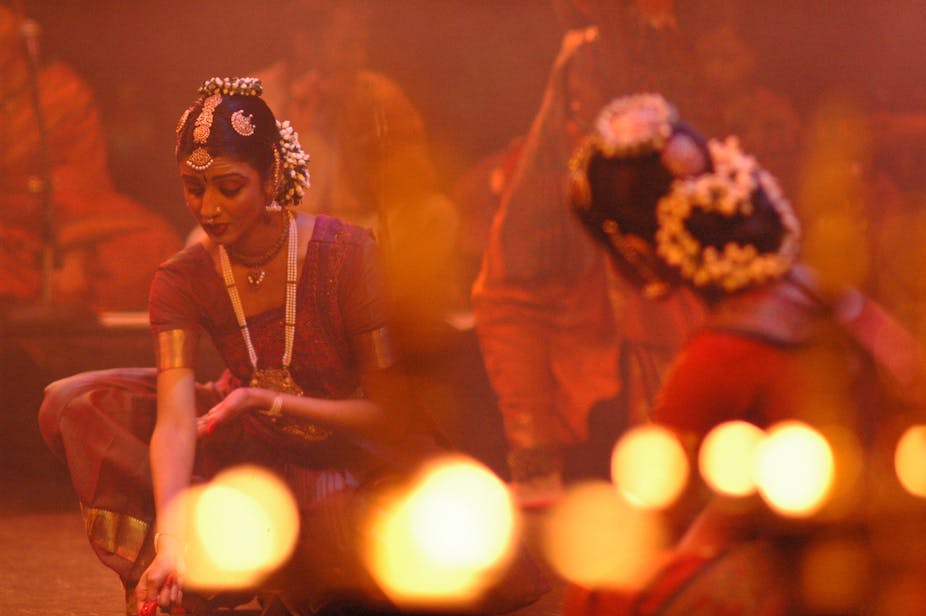There is speculation that the taiko drum was first used by soldiers in battle. At its best, Chi Udaka, currently playing at the Seymour Centre as part of the Sydney Festival, recalls the ritualised diffusing of that battlefield energy, transferred, tamed and controlled (even made useful) through art. It’s a process also found in martial arts as performance – from contemporary Brazilian based Capoeira to the practices of China’s Shaolin Monks.
In Chi Udaka, the cracking rhythms produced by the Australian ensemble TaikOz, practitioners of the Japanese tradition of taiko drumming, meet the articulate and constrained, strength and delicacy of the Indian dancers of the Sydney-based Lingalayam Dance Company.
Cross cultural engagements
In this work, the potential of battle is turned into a field of vibrant exchanges: respectful conversations, dynamic dialogues, and exhilarating competitions, some executed with a touch of tease about them.

Cross discipline and cross cultural engagements have been the site of the some of the most powerful (and painful) experiments in art practice for quite a few decades.
At worst these exchanges are meaningless – a fusion of elements that miss the efficacious potential of rattling the cages of audience expectation. At their best these negotiations between form and practice have produced performances that astound, move and challenge local audiences.
Anadavalli, internationally-renowned dancer, choreographer and teacher of Indian dance forms Bharatha Natyam and Kuchipudi (and artistic director/choreographer of the Lingalayam Dance Company) has been experimenting with collaboration across forms for some time. This experimentation culminated most recently in the amazing Kaal (2013), with Narelle Benjamin, an Australian choreographer who mines yoga for choreographic inspiration, and singer, dancer and storyteller, Parvathy Baul, from India.
Anadavalli does not like the word fusion.
Trained and influenced in and by multiple Indian dance styles she considers her use of various forms in dance as a bringing together of vocabularies “onto the same platform” but “respecting each style”.
Chi Udaka stays true to this vision. This is not a fusion. It is not a combination of forms melded to make something new, but a juxtaposition of expertise that affect each other as they work together. I can’t explain the relation any better than [Anandavali herself](http://www.lingalayam.com/node/134](http://www.lingalayam.com/node/134):
earth and water form the core theme of this collaborative partnership, where separate entities are formed and transformed, creating a kaleidoscope of aural-visual energy, which can be identified as moving configurations. These constantly changing formations create lines and shapes of movement vocabulary that synthesise to form music in dance or dance in music.
TaikOz, also engages regularly in cross disciplinary collaborations – the recent Origin of O (2013) with media and sound artist Tokyo Love In, and local contemporary dancers, is a good example.
Such examples of intercultural exchange can offer contemporary models that mark out, at least in the safe space of a performance space, a place where cultures – their people and practices – can come “together in difference”, in the words of cultural studies scholar Ien Ang.
A space for intercultural exchange
The Seymour Centre’s York Theatre, where Chi Udaka was performed, was one such space.
In this circular expanse with a raked seating bank for 700, which fans out around a sunken stage with a platform proscenium behind (a shape that resembles, in miniature, the theatre spaces of Ancient Greece such as the Temple of Apollo at Delphi), different practices met, their rhythmic similarities and contrasts negotiated.
That negotiation, between a Japanese and an Indian art form, was brokered by other artists who act as conduits, translators, and buffers in this exchange.
There was Riley Lee, with the haunting strains of the long Japanese shakahachi flute, who opens the piece. Aruna Parthiban, an Indian singer whose voice joins Lee’s flute to introduce us to the similarities and contrasts between each tradition. These artists are also joined by the warm, thick sounds of the European cello, played by John Napier.
Together these musicians/ singers reminded me of a ferry master (or the ferry itself), carrying and stabilising us, the audience. Giving us time to pause and recalibrate, even catch our breath, as each section of Chi Udaka engaged us in a new conversation between drummers and dancers.

This is the challenge of collaborations such as this.
How do you bring an audience along with you, an audience perhaps aware of none, or at best only one, of the forms of practice that have made up this collaboration?
You do, I think, exactly what Anadavalli and Ian Clemworth did: you offer us “ferry-masters” to engage us and give us pause. You present a means of framing or translating the work of the major contributors, so we can bring our emerging understanding of those principles with us at the peak of the performance.
Which in this case was a rattling percussion and dance spectacle which saw the drummers descend from their platform, mix with the dancers, who rose to these rhythmic intrusions and provocations with style – their own stamping, head-wiggling, gestural finesse re-occupying the space.
For my money, this was every bit as exciting as a well-staged hip hop battle between opposing crews; I was won over; we were in experienced hands.
Chi Udaka is playing at the York Theatre as part of the Sydney Festival. More details here.
Visit the University of Sydney’s festival hub here.

